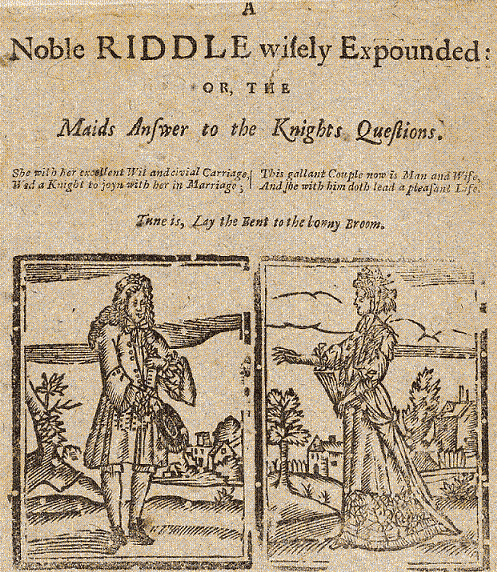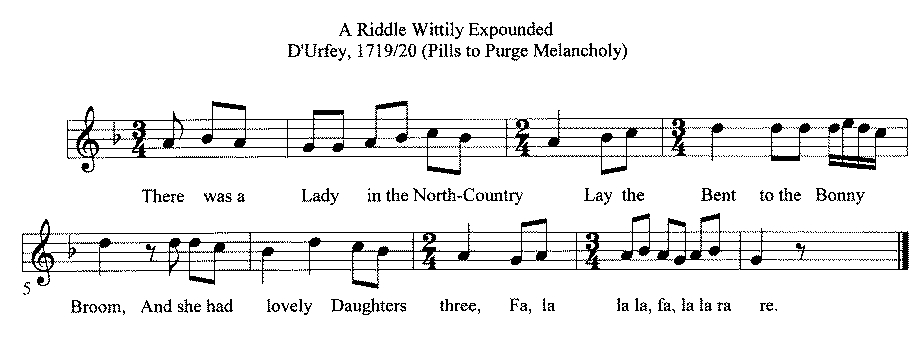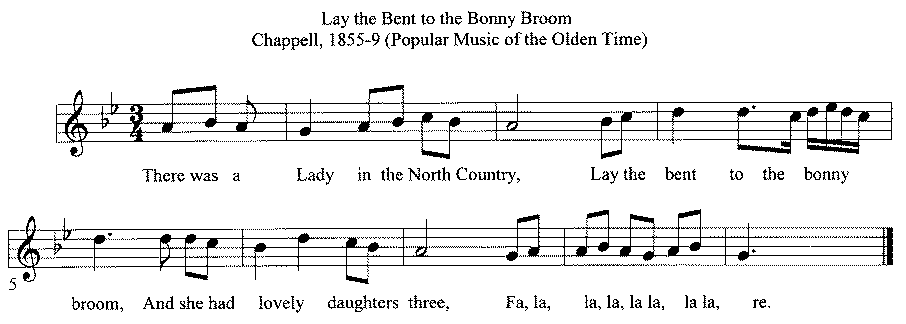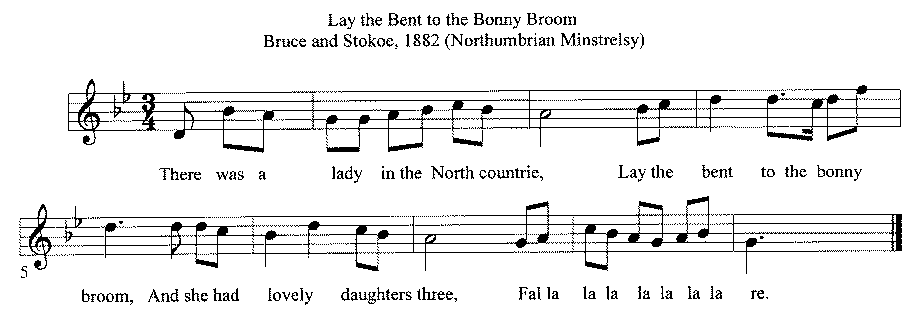Lay the Bent to the Bonny Broom/There was a Lady of the North Country- Child 1 A
[Child 1, Version A is variously titled "A Noble Riddle Wisely Expounded," "A Riddle Wittily Expounded" "Riddles Wisely Expounded(master title)," "Lay the Bent to the Bonny Broom" or "There was a Lady of the North Country." See music below.
1. "A Noble Riddle Wisely Expounded; or, The Maid's Answer to the Knight's Three Questions." Printed for F. Coles, T. Vere, I. Wright, and I. Clarke London, between 1674 and 1679. Child A.
2. "A Noble Riddle Wisely Expounded; or, The Maid's Answer to the Knight's Three Questions." Printed by Tho. Norris, at the Looking glass on London-bridge, about 1711. Child A.
3. "A Riddle Wittily Expounded" Pills to Purge Melancholy, iv, 129, ed. 1719. Child A.
4. "Captain Wedderburn's Courtship[sic]" Jamieson's "Popular Songs and Ballads," 1806. Child A.
5. "Lay the Bent to the Bonny Broom;" Dixon (from print) edited by Bruce and Stokoe, 1882. Child A.
A is the work of an unknown broadside writer based on an earlier print or traditional version similar to Child C or E. The story has been modified so that the Knight is a mortal man.
R. Matteson 2011/2018]

Riddles Wisely Expounded Version A
a.Broadside in the Rawlinson collection, 4to, 566, fol. 193, Wood, E. 25, fol. 15.
b.Pepys, III, 19, No ]7.
c.Douce, II, fol. 168 b.
d.Pills to Purge Melancholy, IV, 130, ed. 1719.
The four copies of A differ but very slightly: a, b, c are broadsides, and d is evidently of that derivation, a and b are of the 17th century. There is another broadside in the Euing collection, formerly Halliwell's, No 253. The version in The Borderer's Table Book, VII, 83, was compounded by Dixon from others previously printed.
Lay the Bent to the Bonny Broom
1 There was a lady of the North Country,
Lay the bent to the bonny broom
And she had lovely daughters three.
Fa la la la, fa la la la ra re.
2 There was knight of noble worth
Lay the bent to the bonny broom
Which also lived in the North.
Fa la la la, fa la la la ra re
3 The knight, of courage stout and brave,
Lay the bent to the bonny broom
A wife he did desire to have.
Fa la la la, fa la la la ra re
4 He knocked at the ladie's gate
Lay the bent to the bonny broom
One evening when it was late.
Fa la la la, fa la la la ra re
5 The eldest sister let him in,
Lay the bent to the bonny broom
And pin'd the door with a silver pin.
Fa la la la, fa la la la ra re
6 The second sister she made his bed,
Lay the bent to the bonny broom
And laid soft pillows under his head.
Fa la la la, fa la la la ra re
7 The youngest daughter that same night,
Lay the bent to the bonny broom
She went to bed to this young knight.
Fa la la la, fa la la la ra re
8 And in the morning, when it was day,
Lay the bent to the bonny broom
These words unto him she did say:
Fa la la la, fa la la la ra re
9 'Now you have had your will,' quoth she,
Lay the bent to the bonny broom
'I pray, sir knight, will you marry me?'
Fa la la la, fa la la la ra re
10 The young brave knight to her replyed,
Lay the bent to the bonny broom
'Thy suit, fair maid, shall not be deny'd.
Fa la la la, fa la la la ra re
11 'If thou canst answer me questions three,
Lay the bent to the bonny broom
This very day will I marry thee.'
Fa la la la, fa la la la ra re
12 'Kind sir, in love, O then,' quoth she,
Lay the bent to the bonny broom
'Tell me what your [three] questions be.'
Fa la la la, fa la la la ra re
13 'O what is longer than the way,
Lay the bent to the bonny broom
Or what is deeper than the sea?
Fa la la la, fa la la la ra re
14 'Or what is louder than the horn,
Lay the bent to the bonny broom
Or what is sharper than a thorn?
Fa la la la, fa la la la ra re
15 'Or what is greener than the grass,
Lay the bent to the bonny broom
Or what is worse then a woman was?'
Fa la la la, fa la la la ra re
16 'O love is longer than the way,
Lay the bent to the bonny broom
And hell is deeper than the sea.
Fa la la la, fa la la la ra re
17 'And thunder is louder than the horn,
Lay the bent to the bonny broom
And hunger is sharper than a thorn.
Fa la la la, fa la la la ra re
18 'And poyson is greener than the grass,
Lay the bent to the bonny broom
And the Devil is worse than woman was.'
Fa la la la, fa la la la ra re
19 When she these questions answered had,
Lay the bent to the bonny broom
The knight became exceeding glad.
Fa la la la, fa la la la ra re
20 And having [truly] try'd her wit,
Lay the bent to the bonny broom
He much commended her for it.
Fa la la la, fa la la la ra re
21 And after, as it is verifi'd,
Lay the bent to the bonny broom
He made of her his lovely bride.
Fa la la la, fa la la la ra re
22 So now, fair maidens all, adieu,
Lay the bent to the bonny broom
This song I dedicate to you.
Fa la la la, fa la la la ra re
23 I wish that you may constant prove
Lay the bent to the bonny broom
Vnto the man that you do love.
Fa la la la, fa la la la ra re
---------------------------------
The top melody is taken from D'Urfey's 1719/20 "Pills to Purge Melancholy". To be more precise, it is a modernized transcription of D'Urfey, from Bronson's "The Singing Tradition of Child's Popular Ballads". D'Urfey, rather than fuss with multiple time signatures, notated the music in throughout. Bronson is meticulous in annotating such changes, but most transcribers are not.

The second melody is Chappell's transcription of D'Urfey. Emphasis on `transcription': This is the music that Chappell reported D'Urfey as having provided. In fact, as is more common in secondary sources than we could wish, Chappell was reporting what he thought D'Urfey should have meant. The key has been changed from G-Dorian to G-minor, the time signature has been regularized (with some effort) to 3/4, and there is a minor note change. (Chappell also adds piano accompaniment and dynamics.)

The third melody is taken from Bruce and Stokoe, who also claim to be relaying D'Urfey's melody. Like Chappell, they notate the music in G-minor (though, since their version has no E's, this now becomes a distinction without a difference), and they regularize the rhythm (differently from Chappell) to 3/4 time. They also modify the notes in a number of places. The modifications to the melody bring it somewhat closer to modern tastes, and most modern recordings of this melody are closer to Bruce and Stokoe than they are to D'Urfey.
